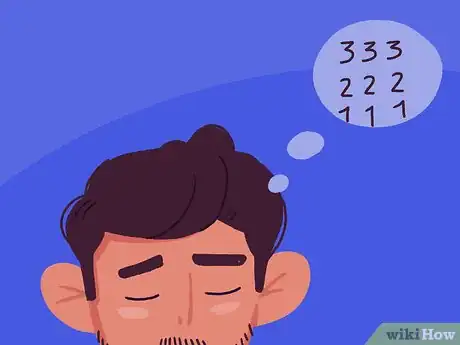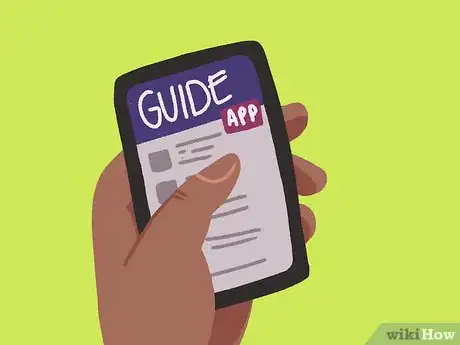This article was co-authored by Michelle Shahbazyan, MS, MA. Michelle Shahbazyan is the Founder of The LA Life Coach, a concierge life, family, and career coaching service based in Los Angeles, California. She has over 10 years of experience with life coaching, consulting, motivational speaking, and matchmaking. She has a BA in Applied Psychology and an MS in Building Construction and Technology Management from Georgia Tech University, and a MA in Psychology with an emphasis on Marriage and Family Therapy from Phillips Graduate University.
There are 9 references cited in this article, which can be found at the bottom of the page.
wikiHow marks an article as reader-approved once it receives enough positive feedback. In this case, 88% of readers who voted found the article helpful, earning it our reader-approved status.
This article has been viewed 279,911 times.
The alpha state of mind is when you reach a very relaxed state while awake. Your brain begins to emit alpha waves instead of beta, which is what you emit when you're fully awake. To enter the alpha state of mind, start by getting relaxed, and then move on to different techniques that can get you in the alpha state of mind, including deep breathing, countdowns, and visualizations. After you relaxing your mind for the alpha state, it's up to you which method you use to achieve it, though it's a good idea to incorporate deep breathing in any other method you choose.
Steps
Relaxing Your Mind and Body
-
1Pick a good time. You don't want to be rushed while you're trying to find your alpha state of mind, particularly if it's your first time. Choose a time where you don't have a million things you should be doing instead. If to-do tasks keep intruding on your meditation time, try making a quick list of what you need to do so you can focus on your mediation.
-
2Get comfy. To go into the alpha state of mind, you need to be relaxed, which means you need to be relatively comfortable. One good position is lying down, so find a comfy couch or bed to relax in.[1]
- You can also sit up in a position you find comfortable. Sitting up can be beneficial if you keep falling asleep while you are lying down.
Advertisement -
3Remove distractions. To find the alpha state of mind, you need to be focused on your meditations. Shut the door so you're not disturbed. Also, try to turn off or block any repetitive noises.[2]
- Turn on some relaxing music if you prefer.
- It can help to close your eyes.
-
4De-clutter your mind. When you're opening your mind up to meditation, don't try to shut down every thought running in your mind. That's futile, as your brain will just fight against that inclination. Instead, try to take a step back and observe the thoughts going through your mind. That way, you're not swept up in those thoughts, but simply observing.[3]
- Focus on the silence that's also a part of your thinking, and try to push your thoughts to the side.
- You could also de-clutter your mind by writing down things you want to do.
Working on Deep Breathing
-
1Breathe in through your nose, out through your mouth. Take a slow, deep breath. As you do, make sure you are pulling the air in through your nose. Slowly exhale the air through your mouth. If you need to, you can breathe just through your nose or your mouth.
-
2Breathe from your diaphragm. When you breathe from your diaphragm, you're taking a much deeper breath than if you breathe from your chest. If you're not sure where you're breathing from, put a hand on your chest and a hand on your diaphragm (stomach area). Take a deep breath. You should see the hand on your diaphragm move more than the one on your chest.[4]
- If your diaphragm isn't moving, take another breath and try to breathe as deeply as you can, making sure your abdomen moves.
-
3Alternate between normal breaths and deep breaths. While you're getting the feel for deep breathing, try going back and forth. Breathe normally for a breath or two, and then switch to taking a slow, deep breath. See how different it feels in comparison.
-
4Count as you inhale and exhale. To ensure you are taking deep breaths, try counting in your head to seven as you breathe in. As you breathe out, count to eight, which will help ensure you push out your air slowly and evenly.[5]
-
5Work in short sessions. Start with a session of ten minutes. Try setting a timer so you're not constantly looking at the clock. Close your eyes, and practice your deep breathing. Breathe in to the count of seven and out to the count of eight.
Using the Countdown Technique
-
1Begin your preliminary countdown. This countdown is just to get you into the state of mind where you can enter a meditative state. Start by imagining the number 3 in your mind as you say it three times. Do the same with 2 and then 1.[6]
-
2Count from 10. Now you start your official countdown. Imagine the number 10 in your mind. As you do, think, "I'm beginning to relax." After a moment, imagine the number 9, and think, "I'm getting calmer."[7]
- Keep going through the numbers. With each number, say a progressively more relaxing phrase, such as "I'm so very relaxed," until you get to one, where you might say, "I'm all the way calm and relaxed, totally in alpha."
-
3Count backwards from 100. Another method is to simply countdown from 100. Do so very slowly, taking about a 2-second break between each number. This slow countdown can help put you in an alpha state of mind.
- Try matching each number with one breath; one number for each combined inhalation and exhalation.
- You can also count up to 100.[8]
-
4Try again. Not everyone reaches an alpha state on their first try. You can try again in the same session. Alternatively, try again at a later time, when you have a chance to begin again with your relaxation techniques.[9]
- If you're feeling frustrated, try taking a break before beginning again.
Trying Visualization
-
1Relax before trying visualization. Try deep breathing before you move into visualization, so that you are completely relaxed as you try to enter the alpha state of mind. Do a ten minute deep breathing session before trying visualization.
-
2Use a guide. Even if you're not in a studio, you can still use a guide for meditation. Free apps are available for guided visualization, and you can also use sites like www.YouTube.com to find guided visualizations.
-
3Approach a peaceful destination. In some ways, visualization is just a form of daydreaming. Start with a short 5 minute session. Pick a place that brings you peace or joy or that you find relaxing. Imagine approaching it. You're not quite there yet, as you'll take the journey in your mind.[12]
- For instance, maybe you picked your favorite cabin in the woods. Close your eyes and imagine you are walking down a path to get to your cabin.
- Try to incorporate all your senses as you walk. What do you see? What do you feel? What do you smell? What do you hear? What can your touch?
- Feel the ground beneath your feet and the cold wind on your skin. Smell the trees. Listen to the sound of your feet crunching on the path and the birds chirping and rustling in the leaves. Notice the dark brown of the wood as you approach the cabin.
-
4Journey through your scenario. Now it's time to enter your destination. Keep approaching it, and as you pass through other areas, imagine all the things your senses are telling you. Imagine what changes as you move through different atmospheres, such as going from outside to inside or moving from room to room.[13]
- For instance, open the cabin door and enter the hallway. Imagine the flickering light above and the smell of the wood that cabin is made of. Feel and hear the stillness and warmth after being outside. Imagine turning a corner and entering the den where there's a fire crackling in the fireplace.
- Pick a place as your final destination, such as the den or the kitchen, and settle yourself in there with your senses.
References
- ↑ https://www.kreolmagazine.com/living/health-well-being/hypnotize-yourself-entering-the-alpha-state-of-mind-2/
- ↑ https://www.kreolmagazine.com/living/health-well-being/hypnotize-yourself-entering-the-alpha-state-of-mind-2/
- ↑ https://www.meditationoasis.com/how-to-meditate/difficulty-meditating/
- ↑ https://psychcentral.com/lib/learning-deep-breathing/
- ↑ https://psychcentral.com/lib/learning-deep-breathing/
- ↑ http://www.mind-energy.net/archives/184-relaxation-technique-6-entering-alpha-state-of-mind-by-yourself.html
- ↑ http://www.mind-energy.net/archives/184-relaxation-technique-6-entering-alpha-state-of-mind-by-yourself.html
- ↑ https://www.kreolmagazine.com/living/health-well-being/hypnotize-yourself-entering-the-alpha-state-of-mind-2/
- ↑ https://www.kreolmagazine.com/living/health-well-being/hypnotize-yourself-entering-the-alpha-state-of-mind-2/
- ↑ https://diethics.com/visualise-a-life-with-no-stress-in-the-alpha-state-of-mind/
- ↑ http://www.wakingtimes.com/2012/03/01/alpha-brain-waves-a-guide-to-understanding/
- ↑ https://diethics.com/visualise-a-life-with-no-stress-in-the-alpha-state-of-mind/
- ↑ https://diethics.com/visualise-a-life-with-no-stress-in-the-alpha-state-of-mind/
About This Article
An alpha state of mind is a state of deep relaxation during which your brain produces alpha waves. To enter an alpha state of mind, choose a time when you’re not too stressed or likely to be distracted so you can focus your mind. Set a timer for 10 minutes. Then, close your eyes and take slow, deep breaths in through your nose and out through your mouth. Once you feel relaxed, use counting or visualization to help your brain produce alpha waves. Try counting down slowly from 100, leaving about 2 seconds between each number. Alternatively, visualize a peaceful scene in your mind’s eye, like a beach or forest. Imagine the scene filling all of your senses. Don’t worry if you get distracted or lose track of your technique, since the important part is staying calm, not being good at visualizing or counting. For more tips, including how to use guided visualization to reach an alpha state of mind, read on!

















































































Medical Disclaimer
The content of this article is not intended to be a substitute for professional medical advice, examination, diagnosis, or treatment. You should always contact your doctor or other qualified healthcare professional before starting, changing, or stopping any kind of health treatment.
Read More...